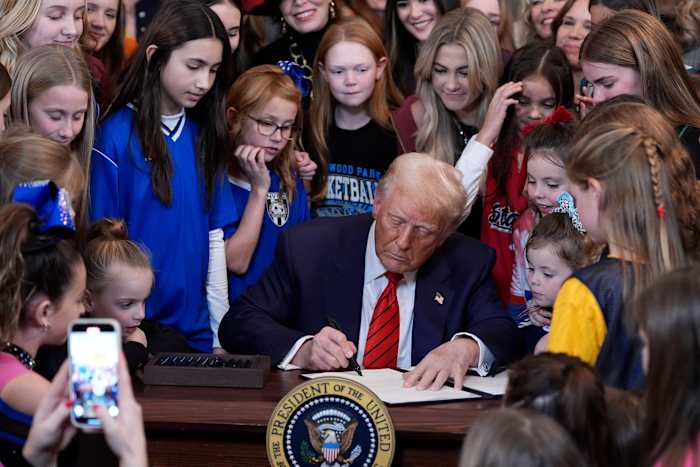Transgender Rights and Political Divides
During his campaign, Donald Trump rallied conservative voters by igniting controversies surrounding transgender individuals’ access to sports and public restrooms. Since returning to office, he has intensified this focus by removing references to transgender people from government websites and passports, and advocating for their exclusion from the military.
A Disproportionate Political Focus
This situation highlights a significant cultural chasm: although transgender individuals constitute less than 1% of the U.S. population, they have become a pivotal topic in political discourse, especially under Trump’s influence.
Civil Rights vs. Public Perception
For transgender individuals, their advocates, and many judges who have ruled against Trump’s policies, the matter is fundamentally about civil rights for a minority group. Conversely, a substantial portion of the American public perceives these rights as overly expansive.
Transgender Day of Visibility
As the focus shifts to Monday’s Transgender Day of Visibility, the tone this year feels markedly different. Rachel Crandall Crocker, Executive Director of Transgender Michigan and founder of the Day of Visibility, expressed, “What he wants is to scare us into being invisible again. We have to show him we won’t go back.”
The Political Dilemma
The escalating attention on transgender issues is part of a longstanding strategy. Trump’s administration reflects a belief that portrays transgender individuals as threats, suggesting they seek access to women’s spaces or are coerced into regrettable gender transitions.
Medical Consensus on Gender-Affirming Care
Prominent medical organizations, including the American Academy of Pediatrics and the American Medical Association, assert that gender-affirming treatments can be medically necessary and are supported by substantial evidence.
Historical Context and Current Impacts
Zein Murib, an associate professor of political science at Fordham University, notes that there has been a sustained effort to re-establish Christian nationalist ideologies in law, which has increasingly targeted transgender individuals since the 2015 U.S. Supreme Court decision on same-sex marriage. The push against transgender rights has gained momentum over recent years.
Shaping Public Discourse
Supporters of restrictions frame their arguments around fairness and safety, drawing attention from the public. Laws banning transgender participation in sports and accessing appropriate bathrooms are often couched in terms of protecting women and girls, despite studies revealing that transgender women are disproportionally affected by violence. Moreover, efforts to prevent schools from supporting gender transitions are linked to claims of protecting parental rights.
State-Level Legislative Trends
Since 2020, numerous states have enacted laws limiting transgender athletes from participating in sports aligned with their gender identity and have imposed restrictions on gender-affirming medical care for minors. Moreover, at least 14 states have introduced laws dictating bathroom access for transgender individuals.
Shifts in Public Opinion
AP VoteCast indicates that a significant majority of voters—55%—believe support for transgender rights in the U.S. has become excessive. While a minority feel the support is adequate, only a small portion believes it hasn’t gone far enough.
Mixed Views on Medical Treatment Bans
Opinions on laws prohibiting gender-affirming medical treatments for minors are divided, with just over half of the public opposed and just under half in favor. Trump voters are especially inclined to assert that transgender rights have exceeded reasonable bounds, while there is notable division among Kamala Harris voters.
Democratic Responses
A recent Pew Research Center survey revealed a slight increase in Democratic support for restricting transgender athletes to compete on teams matching their sex assigned at birth and for prohibiting gender-affirming medical care for minors. Nonetheless, a majority of Democrats continue to oppose such legislative measures.
Political Strategies and Opposing Views
Leor Sapir of the Manhattan Institute observes that the Republican position on transgender issues leaves Democratic opponents in a challenging position, balancing the demands of their progressive base with broader voter concerns. However, opinions differ on this approach’s viability.
Concerns Over Policy Focus
Olivia Hunt, an advocate for transgender equality, remarks on a widespread consensus that the primary challenges facing the U.S. do not pertain to the rights of transgender individuals. Notably, during the same election cycle that saw Trump’s return, Delaware voters elected Sarah McBride as the first transgender member of Congress.
Implications of Conservative Attacks
Paisley Currah, a political science professor, highlights that transgender individuals face increased scrutiny partly due to their minority status. In utilizing the issues surrounding transgender rights as a political tool, Trump is signaling a broader critique of leftist ideologies, branding them as excessive.
Democratic Hesitance
Democratic leaders also recognize that the transgender population is relatively small, resulting in some hesitation to robustly defend their rights. As noted by Seth Masket from the University of Denver, this reluctance is reflected in polling data.
Opposition to Popular Perspectives
Republicans assert that the prevailing support for transgender rights indicates a disconnection from mainstream opinions. Mike Marinella of the National Republican Congressional Committee claimed, “The Democrat Party continues to find themselves on the wrong side of overwhelmingly popular issues.”
Political Strategies Circle
In early March, California Governor Gavin Newsom, a potential presidential candidate for 2028, initiated discussion on his podcast advocating against the inclusion of transgender women and girls in female sports. Several Democratic officials have echoed sentiments suggesting that the party devotes excessive attention to transgender rights, with some voicing opposition to transgender athletes’ participation in women’s sports.
Acceptance Among Younger Generations
Jay Jones, the student government president at Howard University and a transgender woman, expressed that her peers largely embrace transgender individuals. “The Trump administration is trying to weaponize people of the trans experience … to help give an archenemy or a scapegoat,” she noted, adding optimism that this strategy may not achieve the intended results.


